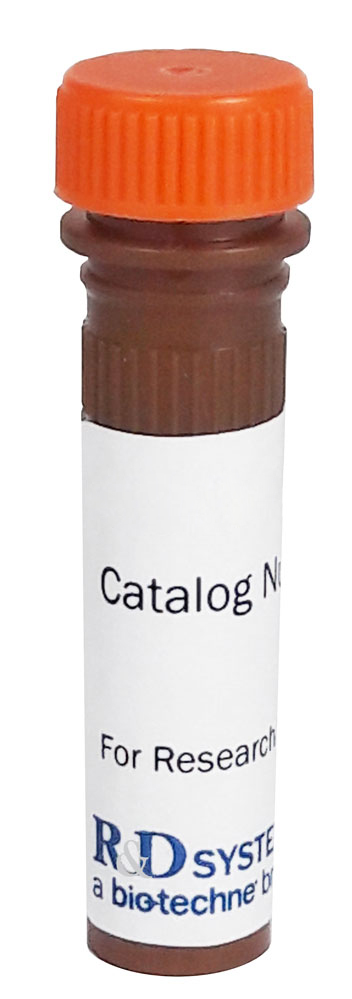Human Fas Ligand/TNFSF6 Alexa Fluor® 488-conjugated Antibody
Human Fas Ligand/TNFSF6 Alexa Fluor® 488-conjugated Antibody Summary
Pro134-Leu281
Accession # P48023
Applications
Please Note: Optimal dilutions should be determined by each laboratory for each application. General Protocols are available in the Technical Information section on our website.
Reconstitution Calculator
Preparation and Storage
- 12 months from date of receipt, 2 to 8 °C as supplied.
Background: Fas Ligand/TNFSF6
Fas Ligand (FasL), also known as CD178, CD95L, or TNFSF6, is a 40 kDa type II transmembrane member of the TNF superfamily of proteins. Its ability to induce apoptosis in target cells plays an important role in the development, homeostasis, and function of the immune system (1). Mature human Fas Ligand consists of a 179 amino acid (aa) extracellular domain (ECD), a 22 aa transmembrane segment, and a 80 aa cytoplasmic domain (2). Within the ECD, human Fas Ligand shares 81% and 78% aa sequence identity with mouse and rat Fas Ligand, respectively. Both mouse and human Fas Ligand are active on mouse and human cells (2, 3). Fas Ligand is expressed on the cell surface as a nondisulfide-linked homotrimer on activated CD4+ Th1 cells, CD8+ cytotoxic T cells, and NK cells (1). Fas Ligand binding to Fas/CD95 on an adjacent cell triggers apoptosis in the Fas‑expressing cell (2, 4). Fas Ligand also binds DcR3 which is a soluble decoy receptor that interferes with Fas Ligand-induced apoptosis (5). Fas Ligand can be released from the cell surface by metalloproteinases as a 26 kDa soluble molecule which remains trimeric (6, 7). Shed Fas Ligand retains the ability to bind Fas, although its ability to trigger apoptosis is dramatically reduced (6, 7). In the absence of TGF‑ beta, however, Fas Ligand/Fas interactions instead promote neutrophil-mediated inflammatory responses (3, 8). Fas Ligand itself transmits reverse signals that costimulate the proliferation of freshly antigen-stimulated T cells (9). Fas Ligand-induced apoptosis plays a central role in the development of immune tolerance and the maintance of immune privileged sites (10). This function is exploited by tumor cells which evade immune surveillance by upregulating Fas Ligand to kill tumor infiltrating lymphocytes (8, 11). In gld mice, a Fas Ligand point mutation is the cause of severe lymphoproliferation and systemic autoimmunity (12, 13).
- Lettau, M. et al. (2008) Curr. Med. Chem. 15:1684.
- Takahashi, T. et al. (1994) Int. Immunol. 6:1567.
- Seino, K-I. et al. (1998) J. Immunol. 161:4484.
- Suda, T. et al. (1993) Cell 75:1169.
- Pitti, R.M. et al. (1998) Nature 396:699.
- Schneider, P. et al. (1998) J. Exp. Med. 187:1205.
- Tanaka, M. et al. (1998) Nature Med. 4:31.
- Chen, J-J. et al. (1998) Science 282:1714.
- Suzuki, I. and P.J. Fink (2000) Proc. Natl. Acad. Sci. USA 97:1707.
- Ferguson, T.A. and T.S. Griffith (2006) Immunol. Rev. 213:228.
- Ryan, A.E. et al. (2005) Cancer Res. 65:9817.
- Takahashi, T. et al. (1994) Cell 76:969.
- Lynch, D.H. et al. (1994) Immunity 1:131.
Product Datasheets
Product Specific Notices
This product is provided under an agreement between Life Technologies Corporation and R&D Systems, Inc, and the manufacture, use, sale or import of this product is subject to one or more US patents and corresponding non-US equivalents, owned by Life Technologies Corporation and its affiliates. The purchase of this product conveys to the buyer the non-transferable right to use the purchased amount of the product and components of the product only in research conducted by the buyer (whether the buyer is an academic or for-profit entity). The sale of this product is expressly conditioned on the buyer not using the product or its components (1) in manufacturing; (2) to provide a service, information, or data to an unaffiliated third party for payment; (3) for therapeutic, diagnostic or prophylactic purposes; (4) to resell, sell, or otherwise transfer this product or its components to any third party, or for any other commercial purpose. Life Technologies Corporation will not assert a claim against the buyer of the infringement of the above patents based on the manufacture, use or sale of a commercial product developed in research by the buyer in which this product or its components was employed, provided that neither this product nor any of its components was used in the manufacture of such product. For information on purchasing a license to this product for purposes other than research, contact Life Technologies Corporation, Cell Analysis Business Unit, Business Development, 29851 Willow Creek Road, Eugene, OR 97402, Tel: (541) 465-8300. Fax: (541) 335-0354.
FAQs
No product specific FAQs exist for this product, however you may
View all Antibody FAQsReviews for Human Fas Ligand/TNFSF6 Alexa Fluor® 488-conjugated Antibody
There are currently no reviews for this product. Be the first to review Human Fas Ligand/TNFSF6 Alexa Fluor® 488-conjugated Antibody and earn rewards!
Have you used Human Fas Ligand/TNFSF6 Alexa Fluor® 488-conjugated Antibody?
Submit a review and receive an Amazon gift card.
$25/€18/£15/$25CAN/¥75 Yuan/¥1250 Yen for a review with an image
$10/€7/£6/$10 CAD/¥70 Yuan/¥1110 Yen for a review without an image






